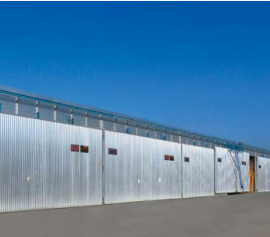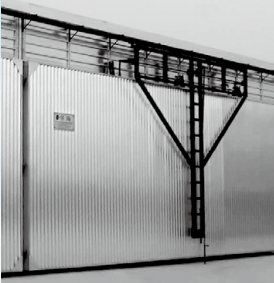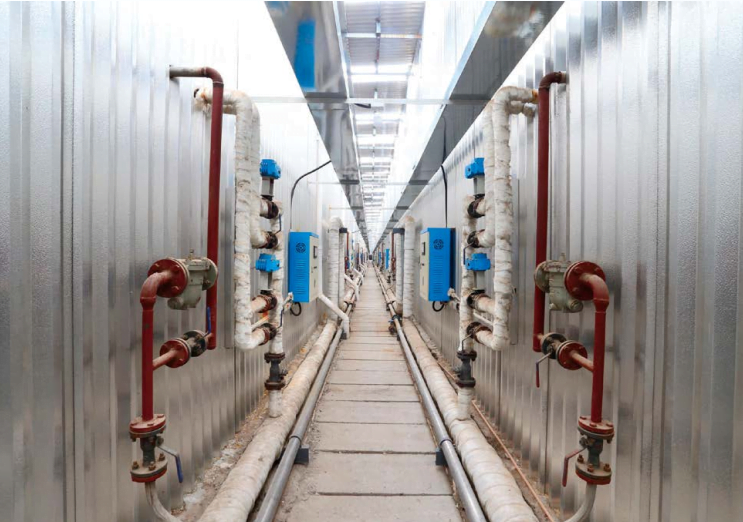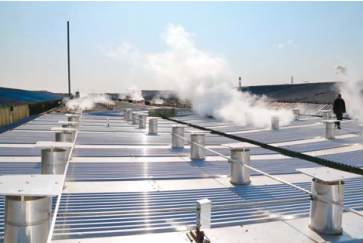A conventional steam wood drying kiln uses steam flow into the kiln through pipes and radiates heat into the kiln’s atmosphere. Water content of the wood is converted into vapor by evaporation and discharged from the kiln with the hot air.

Kiln Structure
Skeletal system of the kiln is consisted with aluminum frame which is a special-shaped aluminum profile developed and designed by us. Stainless steel bolt is used to connect aluminum profiles and aluminum plates. The joint is sealed with special sealant to ensure the tightness of kiln. The aluminum plate in the kiln adopts the aluminum flat plate and the grooved aluminum plate structure, and the outer aluminum plate adopts the 750-type large corrugated aluminum plate, which has good rigidity and beautiful appearance. The inner and outer plates of the kiln wall are filled with large bulk glass wool insulation, and the heat preservation effect is excellent, effectively reduce the heat loss of the drying kiln during the working process.
The overall appearance of the kiln is sturdy and durable, which can ensure normal operation in harsh environments such as wind load and snow load in alpine regions.
Kiln Door
The dry kiln has an integral lifting type gate which is aluminum alloy structure with special aluminum profile made into the door frame. The aluminum plates inside of the kiln are constructed out of flat aluminum plate and groove profile structure. The outer aluminum plates are 750-type large corrugated aluminum plates. Large bulk density glass wool is filled in the middle to provide heat-resistance and special sealant is used to seal the joints of inner boards of kiln door.
Door opening: adopt special lifting device, after the door is lifted, it can move laterally along the door track. After fully open, woods can be loaded into the kiln.
Door closing: push the lifting device to the position of the door. When the kiln door is put down, the two sides of the kiln door are locked tightly against the self-weight of the door, and the sealing strip around the door is pressed tightly to the frame of the door for sealing.
Test door: arranged in the control room of the back wall of the kiln. During the drying process, technicians inspect and exit the kiln through the test door to detect the wood in the kiln in real time. Aluminum alloy structure, rotary safety door lock, safe and reliable.



Heating and spraying
In the wood drying process, the heating and humidification in the kiln are realized by the heating and spraying system. The steam heat source realizes the thermal cycle of heating in the kiln through the control valve group, the connecting pipe, the radiator and the return valve group.
Humidification is carried out by steam spraying valve group and spraying pipeline. Steam is sprayed to the kiln through the steam spraying hole of the spraying pipeline in the kiln, and the humidification process is also a heating process.
High quality electric valve is used for control of heating and steam spraying, with accurate control and stable performance. Backwater adopts floating ball trap, which can effectively reduce heat loss and increase the utilization rate of heat energy.

In the way of pressure dehumidification, the dehumidification cylinder is arranged symmetrically on both sides of the fan, and the dehumidification is carried out through the pressure difference of the circulating inlet and outlet end of the fan. The wet bulb in one side discharges the humid air in the kiln, and the other side draws in the dry air from the outside.
The dehumidification system is composed of dehumidification tube, connecting rod and electric actuator of air valve.
The air valve electric actuator adopts Siemens from Germany, and its performance is stable and reliable.
The design of the top air circulation method is 1.0 m below the roof of the kiln.
It divides the space inside the kiln into two parts
The upper part is the fan room, in which the fan is installed, and the lower part is the drying kiln for wood. The area of the second shed is smaller than the area of the kiln roof.
At the front and rear ends of the kiln there are ventilation ducts of 0.8-1.0 m each. The radiator is fixed to the second shed.
The air from the fan is heated by the radiator and then flows in and out of the pile from one side.
The air from the fan is heated by the radiator and then flows in and out of the pile from one side and out from the other side of the pile, forming a circulating circuit of air flow in the kiln.
The air from the fan is heated by the radiator and then flows in and out of the pile from one side and out from the other side of the pile, forming an air circulation circuit in the kiln to heat and dry the wood. The motor rotates forward and reverse to change the airflow in the kiln.
The air circulation direction in the kiln is changed by the motor turning forward and backward at regular intervals to ensure uniform drying of wood in the kiln.


Control
There are two types of control systems: semi automatic control and fully automatic control. Instrumentation by controlling the opening and closing of valves to change the temperature and humidity in the drying kiln. Temperature control is done by controlling the heating electric valve opening of the heat source delivered to the kiln heating system.
The temperature control is achieved by controlling the heating motorized valve opening and closing to change the heat source delivered to the kiln heating system. Humidity is controlled by the spray electric valve to control the spraying and the electric actuator to control the air valve The humidity is achieved by controlling the spraying through the spray electric valve and by controlling the draught valve electric actuator to discharge the humidity.
Semi-automatic control: Also known as stage automatic control, in each drying stage The equipment operates automatically. The drying stages are determined by different the same wood drying process, and the drying .The drying technician sets his own drying process values. After setting, the equipment operates fully automatically.
Fully automatic control: The operator technician The operator can input the wood drying process program or directly select the solid wood drying process in the control instrument.
The operator can input the wood drying process or directly select the fixed wood drying process in the control instrument for wood drying.
The automatic control system automatically detects the kiln temperature, and moisture content according to the detected data to achieve.
Specs - Conventional steam wood drying kiln
| Model | Piling Size (m) Width x Depth x Height | Kiln Inner Size (m) Width x Depth x Height | Qty Of 2.2kw Motors | Steam Consumption (kg/h) | Total Power kw |
|---|---|---|---|---|---|
| HHJ-40 | 4.0×4.8×4.3 | 4.5×6.4×5.6 | 2 | 200 | 5 |
| HHJ-50 | 4.0×6.0×4.3 | 4.5×8.0×5.6 | 3 | 250 | 7 |
| HHJ-60 | 6.0×4.8×4.3 | 6.6×6.4×5.6 | 3 | 300 | 7 |
| HHJ-80 | 8.0×4.8×4.3 | 8.6×6.4×5.6 | 4 | 400 | 9 |
| HHJ-100 | 8.0×6.0×4.3 | 8.6×8.0×5.6 | 5 | 500 | 12 |
| HHJ-120 | 10.0×6.0×4.3 | 10.6×8.0×5.6 | 6 | 600 | 14 |
| HHJ-150 | 12.0×6.0×4.3 | 12.8×8.0×5.6 | 8 | 750 | 18 |
| HHJ-200 | 12.0×7.0×4.3 | 12.8×9.2×6.4 | 10 | 1000 | 23 |